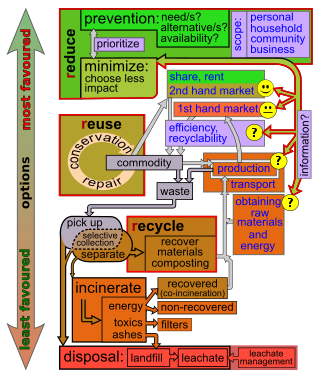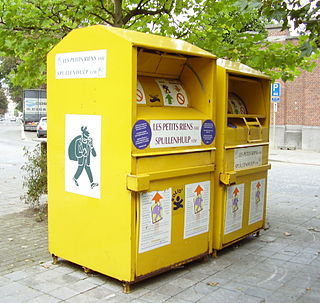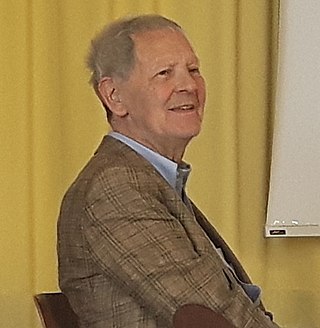Related Research Articles

Recycling is the process of converting waste materials into new materials and objects. This concept often includes the recovery of energy from waste materials. The recyclability of a material depends on its ability to reacquire the properties it had in its original state. It is an alternative to "conventional" waste disposal that can save material and help lower greenhouse gas emissions. It can also prevent the waste of potentially useful materials and reduce the consumption of fresh raw materials, reducing energy use, air pollution and water pollution.

Waste management or waste disposal includes the processes and actions required to manage waste from its inception to its final disposal. This includes the collection, transport, treatment, and disposal of waste, together with monitoring and regulation of the waste management process and waste-related laws, technologies, and economic mechanisms.
Industrial ecology (IE) is the study of material and energy flows through industrial systems. The global industrial economy can be modelled as a network of industrial processes that extract resources from the Earth and transform those resources into by-products, products and services which can be bought and sold to meet the needs of humanity. Industrial ecology seeks to quantify the material flows and document the industrial processes that make modern society function. Industrial ecologists are often concerned with the impacts that industrial activities have on the environment, with use of the planet's supply of natural resources, and with problems of waste disposal. Industrial ecology is a young but growing multidisciplinary field of research which combines aspects of engineering, economics, sociology, toxicology and the natural sciences.

Zero waste, or waste minimization, is a set of principles focused on waste prevention that encourages redesigning resource life cycles so that all products are repurposed and/or reused. The goal of the movement is to avoid sending trash to landfills, incinerators, oceans, or any other part of the environment. Currently 9% of global plastic is recycled. In a zero waste system, all materials are reused until the optimum level of consumption is reached.

Waste hierarchy is a tool used in the evaluation of processes that protect the environment alongside resource and energy consumption from most favourable to least favourable actions. The hierarchy establishes preferred program priorities based on sustainability. To be sustainable, waste management cannot be solved only with technical end-of-pipe solutions and an integrated approach is necessary.

Material efficiency is a description or metric ((Mp) (the ratio of material used to the supplied material)) which refers to decreasing the amount of a particular material needed to produce a specific product. Making a usable item out of thinner stock than a prior version increases the material efficiency of the manufacturing process. Material efficiency is associated with Green building and Energy conservation, as well as other ways of incorporating Renewable resources in the building process from start to finish.
Remanufacturing is "the rebuilding of a product to specifications of the original manufactured product using a combination of reused, repaired and new parts". It requires the repair or replacement of worn out or obsolete components and modules. Parts subject to degradation affecting the performance or the expected life of the whole are replaced. Remanufacturing is a form of a product recovery process that differs from other recovery processes in its completeness: a remanufactured machine should match the same customer expectation as new machines.

Pollution prevention (P2) is a strategy for reducing the amount of waste created and released into the environment, particularly by industrial facilities, agriculture, or consumers. Many large corporations view P2 as a method of improving the efficiency and profitability of production processes through waste reduction and technology advancements. Legislative bodies have enacted P2 measures, such as the Pollution Prevention Act of 1990 and the Clean Air Act Amendments of 1990 in the United States Congress.

Reuse is the action or practice of using an item, whether for its original purpose or to fulfill a different function. It should be distinguished from recycling, which is the breaking down of used items to make raw materials for the manufacture of new products. Reuse – by taking, but not reprocessing, previously used items – helps save time, money, energy and resources. In broader economic terms, it can make quality products available to people and organizations with limited means, while generating jobs and business activity that contribute to the economy.

Waste minimisation is a set of processes and practices intended to reduce the amount of waste produced. By reducing or eliminating the generation of harmful and persistent wastes, waste minimisation supports efforts to promote a more sustainable society. Waste minimisation involves redesigning products and processes and/or changing societal patterns of consumption and production.

Textile recycling is the process of recovering fiber, yarn, or fabric and reprocessing the material into new, useful products. Textile waste is split into pre-consumer and post-consumer waste and is sorted into five different categories derived from a pyramid model. Textiles can be either reused or mechanically/chemically recycled.
Source reduction is activities designed to reduce the volume, mass, or toxicity of products throughout the life cycle. It includes the design and manufacture, use, and disposal of products with minimum toxic content, minimum volume of material, and/or a longer useful life.
The Professional Electrical Apparatus Reconditioning League or PEARL is an international professional organization and standards group based in Denver, Colorado. PEARL is focused on developing ethical business practices and technical standards related to inspecting, testing, and reconditioning circuit breakers, transformer, motor controls, switchgear, disconnect switches, protective relays, bus duct, motor starters and other electrical equipment and apparatus used in the electrical distribution systems of commercial, industrial, and utility facilities.

Walter R. Stahel is a Swiss architect, graduating from the Swiss Federal Institute of Technology Zürich in 1971. He has been influential in developing the field of sustainability, by advocating 'service-life extension of goods - reuse, refill, reprogram, repair, remanufacture, upgrade technologically' philosophies as they apply to industrialised economies. He co-founded the Product Life Institute in Geneva, Switzerland, a consultancy devoted to developing sustainable strategies and policies, after receiving recognition for his prize winning paper 'The Product Life Factor' in 1982. His ideas and those of similar theorists led to what is now known as the circular economy in which industry adopts the reuse and service-life extension of goods as a strategy of waste prevention, regional job creation and resource efficiency in order to decouple wealth from resource consumption, that is to dematerialise the industrial economy. The circular economy has been adopted by the state-owned-and-run China Coal industry as a guiding philosophy. In the 1990s, Stahel extended this vision to selling goods as services as the most efficient strategy of the circular economy. He described this approach in his 2006 book The Performance Economy, with a second enlarged edition in 2010 which contains 300 examples and case studies. he currently works closely with the Ellen MacArthur Foundation on further promoting his ideas with economic actors.

A circular economy is a model of resource production and consumption in any economy that involves sharing, leasing, reusing, repairing, refurbishing, and recycling existing materials and products for as long as possible. The concept aims to tackle global challenges such as climate change, biodiversity loss, waste, and pollution by emphasizing the design-based implementation of the three base principles of the model. The three principles required for the transformation to a circular economy are: designing out waste and pollution; keeping products and materials in use, and regenerating natural systems." CE is defined in contradistinction to the traditional linear economy. The idea and concepts of a circular economy have been studied extensively in academia, business, and government over the past ten years. It has been gaining popularity because it can help to minimize carbon emissions and the consumption of raw materials, open up new market prospects, and, principally, increase the sustainability of consumption.
Resource recovery is using wastes as an input material to create valuable products as new outputs. The aim is to reduce the amount of waste generated, thereby reducing the need for landfill space, and optimising the values created from waste. Resource recovery delays the need to use raw materials in the manufacturing process. Materials found in municipal solid waste, construction and demolition waste, commercial waste and industrial wastes can be used to recover resources for the manufacturing of new materials and products. Plastic, paper, aluminium, glass and metal are examples of where value can be found in waste.
A circular economy is an alternative way countries manage their resources, where instead of using products in the traditional linear make, use, dispose method, resources are used for their maximum utility throughout their life cycle and regenerated in a cyclical pattern minimizing waste. They strive to create economic development through environmental and resource protection. The ideas of a circular economy were officially adopted by China in 2002, when the 16th National Congress of the Chinese Communist Party legislated it as a national endeavour, though various sustainability initiatives were implemented in the previous decades starting in 1973. China adopted the circular economy due to the environmental damage and resource depletion that was occurring from going through its industrialization process. China is currently a world leader in the production of resources, where it produces 46% of the world's aluminum, 50% of steel and 60% of cement, while it has consumed more raw materials than all the countries a part of the Organisation for Economic Co-operation and Development (OECD) combined. In 2014, China created 3.2 billion tonnes of industrial solid waste, where 2 billion tonnes were recovered using recycling, incineration, reusing and composting. By 2025, China is anticipated to produce up to one quarter of the world's municipal solid waste.
A take-back system or simply takeback is one of the primary channels of waste collection, especially for e-waste, besides municipal sites. Take-back is the idea that manufacturers and sellers "take back" the products that are at the end of their lives. Take-back is aimed to reduce a business' environmental impacts on the earth and also increase efficiency and lower costs for their business models. "Take-back regulations have targeted a wide array of products including packaging, batteries, automobiles, and electronics", and economic value can be found from recycling or re-manufacturing such products. "The programs benefit municipalities by lowering their overall waste disposal costs and reducing the burden on landfill sites". Although for certain companies, the take-back system is mandatory under legislation, many do it voluntarily.
Christopher Alan McMahon is a British mechanical engineer, academic and a researcher. He is a retired professor of engineering design and serves as senior research fellow and senior associate teacher at the University of Bristol.
Green supply chain management (GSCM) is the consideration of environmental issues in supply chain management.
References
- ↑ Greyson, James (2006). "An economic instrument for zero waste, economic growth and sustainability". Journal of Cleaner Production. 15 (2007): 1382–1390. doi:10.1016/j.jclepro.2006.07.019.
- 1 2 Gillian, Sheryl; Werner, Carol M.; Olson, Lynne; Adams, Dorothy (1996). "Teaching the concept of precycling: a campaign and evaluation". The Journal of Environmental Education. 28 (1): 11. doi:10.1080/00958964.1996.9942810.
- ↑ O'Leary, Philip R; Walsh, Patrick W (1999). "Source Reduction: Final Report" (PDF). Decision Maker's Guide to Solid Waste Management. 2: 5.
- ↑ O'Leary, Philip R; Walsh, Patrick W (1999). "Source Reduction: Final Report" (PDF). Decision Maker's Guide to Solid Waste Management. 2: 6.
- 1 2 3 4 Greyson, James (2006). "An economic instrument for zero waste, economic growth and sustainability". Journal of Cleaner Production. 15 (2007): 1385.
- ↑ DiChristina, Mariette (1990). "How We Can Win The War Against Garbage". Popular Science. Vol. 237, no. 4. p. 63.
- ↑ Cox, Jayne; Giorgi, Sarah; Veronica, Sharp; Strange, Kit; Wilson, David C.; Blakey, Nick (2010). "Household waste prevention - a review of evidence". Waste Management & Research. 28 (3): 193–219. doi:10.1177/0734242x10361506. PMID 20215491. S2CID 19607910.
- 1 2 King, Andrew M.; Burgess, Stuart C.; Ijomah, Winnie; McMahon, Chris A. (2006). "Reducing waste: repair, recondition, remanufacture or recycle?". Sustainable Development. 14 (4): 257–267. doi:10.1002/sd.271.
- 1 2 3 Seadon, Jeffrey K. (2010). "Sustainable waste management systems". Journal of Cleaner Production. 18 (16): 1646. doi:10.1016/j.jclepro.2010.07.009.
- ↑ Cox, Jayne; Giorgi, Sarah; Veronica, Sharp; Strange, Kit; Wilson, David C.; Blakey, Nick (2010). "Household waste prevention - a review of evidence". Waste Management & Research. 28 (3): 212. doi:10.1177/0734242x10361506. PMID 20215491. S2CID 19607910.
- 1 2 3 Hammer, Marie; Papadi, Joan; Gutter, Michael (2007). "Enviroshopping: Buy Smarter": 5.
{{cite journal}}: Cite journal requires|journal=(help) - ↑ Bushnell, Kristen; Harpster, Amy; Simchuk, Sarah; Manckia, Jen; Stevens, Cathy (2009). "Reduce, Reuse, Recycle": 1.
{{cite journal}}: Cite journal requires|journal=(help) - 1 2 Cox, Jayne; Giorgi, Sarah; Veronica, Sharp; Strange, Kit; Wilson, David C.; Blakey, Nick (2010). "Household waste prevention - a review of evidence". Waste Management & Research. 28 (3): 195. doi:10.1177/0734242x10361506. PMID 20215491. S2CID 19607910.
- ↑ King, Andrew M.; Burgess, Stuart C.; Ijomah, Winnie; McMahon, Chris A. (2006). "Reducing waste: repair, recondition, remanufacture or recycle?". Sustainable Development. 14 (4): 263. doi:10.1002/sd.271.
- ↑ Krug, Donna; County Agency, Barton (2009). "It's Easy to be Green": 2.
{{cite journal}}: Cite journal requires|journal=(help) - 1 2 King, Andrew M.; Burgess, Stuart C.; Ijomah, Winnie; McMahon, Chris A. (2006). "Reducing waste: repair, recondition, remanufacture or recycle?" (PDF). Sustainable Development. 14 (4): 260. doi:10.1002/sd.271.
- 1 2 3 4 King, Andrew M.; Burgess, Stuart C.; Ijomah, Winnie; McMahon, Chris A. (2006). "Reducing waste: repair, recondition, remanufacture or recycle?" (PDF). Sustainable Development. 14 (4): 261. doi:10.1002/sd.271.
- 1 2 Greyson, James (2006). "An economic instrument for zero waste, economic growth and sustainability". Journal of Cleaner Production. 15 (2007): 1382. doi:10.1016/j.jclepro.2006.07.019.
- 1 2 3 Curbside Cleanup, Day (2012). "Garbage & Recycling". Earth. 7: 1.
- 1 2 Seadon, Jeffrey K. (2010). "Sustainable waste management systems". Journal of Cleaner Production. 18 (16): 1649. doi:10.1016/j.jclepro.2010.07.009.
- 1 2 Greyson, James (2006). "An economic instrument for zero waste, economic growth and sustainability". Journal of Cleaner Production. 15 (2007): 1383.
- ↑ Greyson, James (2006). "An economic instrument for zero waste, economic growth and sustainability". Journal of Cleaner Production. 15 (2007): 1384.
- ↑ King, Andrew M.; Burgess, Stuart C.; Ijomah, Winnie; McMahon, Chris A. (2006). "Reducing waste: repair, recondition, remanufacture or recycle?" (PDF). Sustainable Development. 14 (4): 259. doi:10.1002/sd.271.
- 1 2 3 Greyson, James (2006). "An economic instrument for zero waste, economic growth and sustainability". Journal of Cleaner Production. 15 (2007): 1386.
- 1 2 3 4 Greyson, James (2006). "An economic instrument for zero waste, economic growth and sustainability". Journal of Cleaner Production. 15 (2007): 1387.
- ↑ Cox, Jayne; Giorgi, Sarah; Veronica, Sharp; Strange, Kit; Wilson, David C.; Blakey, Nick (2010). "Household waste prevention - a review of evidence". Waste Management & Research. 28 (3): 204. doi:10.1177/0734242x10361506. PMID 20215491. S2CID 19607910.
- ↑ King, Andrew M.; Burgess, Stuart C.; Ijomah, Winnie; McMahon, Chris A. (2006). "Reducing waste: repair, recondition, remanufacture or recycle?" (PDF). Sustainable Development. 14 (4): 258. doi:10.1002/sd.271.
- 1 2 3 Greyson, James (2006). "An economic instrument for zero waste, economic growth and sustainability". Journal of Cleaner Production. 15 (2007): 1388.
- ↑ King, Andrew M.; Burgess, Stuart C.; Ijomah, Winnie; McMahon, Chris A. (2006). "Reducing waste: repair, recondition, remanufacture or recycle?" (PDF). Sustainable Development. 14 (4): 265. doi:10.1002/sd.271.
- ↑ Hopewell, Jefferson; Dvorak, Robert; Kosior, Edward (2009). "Plastics recycling: challenges and opportunities". Philosophical Transactions of the Royal Society B: Biological Sciences. 364 (1526): 2124. doi:10.1098/rstb.2008.0311. PMC 2873020 . PMID 19528059.
- ↑ Gillian, Sheryl; Werner, Carol M.; Olson, Lynne; Adams, Dorothy (1996). "Teaching the concept of precycling: a campaign and evaluation". The Journal of Environmental Education. 28 (1): 12. doi:10.1080/00958964.1996.9942810.
- ↑ Gillian, Sheryl; Werner, Carol M.; Olson, Lynne; Adams, Dorothy (1996). "Teaching the concept of precycling: a campaign and evaluation". The Journal of Environmental Education. 28 (1): 16. doi:10.1080/00958964.1996.9942810.
- 1 2 Hammer, Marie; Papadi, Joan; Gutter, Michael (2007). "Enviroshopping: Buy Smarter": 3.
{{cite journal}}: Cite journal requires|journal=(help) - ↑ Cox, Jayne; Giorgi, Sarah; Veronica, Sharp; Strange, Kit; Wilson, David C.; Blakey, Nick (2010). "Household waste prevention - a review of evidence". Waste Management & Research. 28 (3): 196. doi:10.1177/0734242x10361506. PMID 20215491. S2CID 19607910.
- ↑ "Precycling". Environmental Encyclopedia. Gale Virtual Reference Library.
- ↑ Seadon, Jeffrey K. (2010). "Sustainable waste management systems". Journal of Cleaner Production. 18 (16): 1647. doi:10.1016/j.jclepro.2010.07.009.
- ↑ Greyson, James (2006). "An economic instrument for zero waste, economic growth and sustainability". Journal of Cleaner Production. 15 (2007): 1389.
- ↑ Curbside Cleanup, Day (2012). "Garbage & Recycling". Earth. 7: 2.
- ↑ Cox, Jayne; Giorgi, Sarah; Veronica, Sharp; Strange, Kit; Wilson, David C.; Blakey, Nick (2010). "Household waste prevention - a review of evidence". Waste Management & Research. 28 (3): 200. doi:10.1177/0734242x10361506. PMID 20215491. S2CID 19607910.
- "Precycle: Reducing Waste Right From the Start". Archived from the original on March 13, 2006. Retrieved October 20, 2006.
